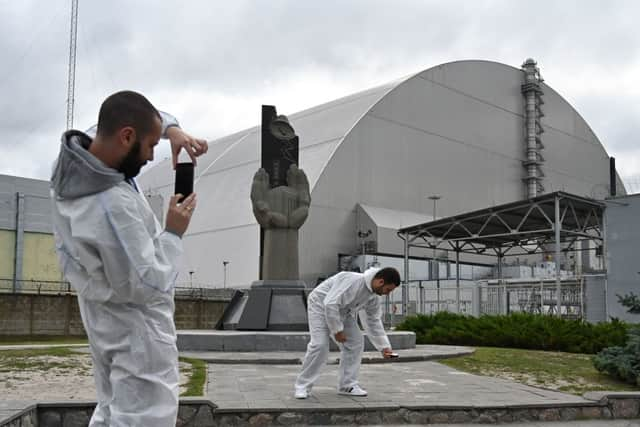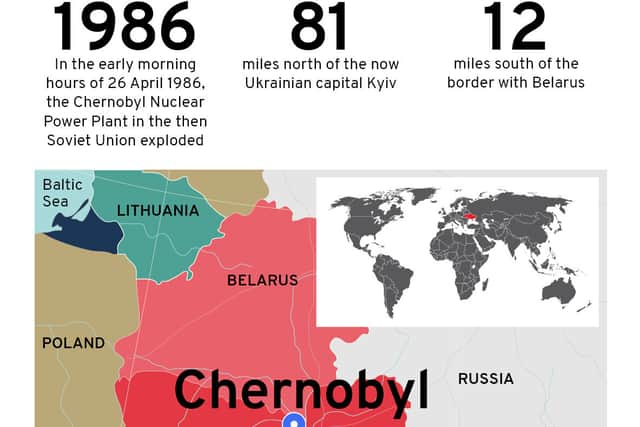Chernobyl: Ukraine disaster explained, are radiation levels high today - why did Russia capture nuclear plant?
and live on Freeview channel 276
On the day of the Chernobyl disaster's anniversary (26 April), radiation levels at the nuclear power facility in Ukraine have reached abnormally high levels.
According to AFP, Director General Rafael Grossi of the International Atomic Energy Agency warned reporters that Russia's weeks-long takeover of the site was "very, very dangerous."
Advertisement
Hide AdAdvertisement
Hide AdBut what would Russia want with the plant, and what does it mean for the conflict?
Here is everything you need to know.
What happened at Chernobyl in 1986?
A reactor at the Chernobyl nuclear power plant exploded in April 1986, spewing radioactive waste across Europe.
It has been estimated that 400 times more radioactive material was released into the air than when the atomic bomb was dropped on Hiroshima in Japan towards the end of the Second World War.
Firefighters tried to put out a series of fires at the plant, and eventually helicopters were drafted in to dump sand and other materials on the blazes in order to try and contain the contamination.
Advertisement
Hide AdAdvertisement
Hide AdThe entire town of Pripyat was completely evacuated, and during the following weeks and months an additional 67,000 people were evacuated from their homes.
In December that year, a protective “sarcophagus” was built and placed over the power plant in order to reduce the spread of radioactive contamination.


The deteriorating sarcophagus containing the reactor was covered in 2017 with an enormous shelter aimed at containing radiation still leaking from the accident until the site can be dismantled, which is expected to take until 2064.
In 2019, the disaster became the subject of a critically acclaimed co-produced Sky and HBO series which dramatised the story of the nuclear accident.
Read more - Chernobyl disaster: what happened?
Why did Russia capture Chernobyl?
Advertisement
Hide AdAdvertisement
Hide AdRussian forces launched a full-scale invasion of Ukraine in the early hours of 24 February, Moscow’s most aggressive action since the Soviet invasion of Afghanistan in 1979.
In the days that followed, Russia’s defence ministry issued a statement claiming its troops are holding the Chernobyl nuclear plant in order to “protect it”.
It said it is had done so to ensure that “nationalistic groups and other terrorist organisations cannot use the situation in the country in order to stage a nuclear provocation”.
At the time, it was suggested that Russia may in fact have chosen to capture the Chernobyl nuclear plant because strategically “it was just in the way” of its military plans.
Advertisement
Hide AdAdvertisement
Hide AdNick Reynolds, a land warfare analyst with the Rusi think tank, said the site of the nuclear reactor 80 miles north of the capital Kyiv could have been “just in the way” of the Russian forces who were crossing into Ukraine.


Reynolds said it “is a little bit of a mystery” why Chernobyl would have been chosen for capture, and that Ukrainian defence plans have been closely guarded for reasons of operational security.
He said: “Going through the Chernobyl zone is one of the shortest routes to get from Belarus to Kyiv. It is an exclusion zone that is heavily irradiated, which means it is, by all accounts, not as heavily defended as other areas.”
The exclusion zone refers to a 30km radius around the accident site which was evacuated and placed under military control. This was the area that experienced the largest amount of radioactive contamination from the disaster.
Advertisement
Hide AdAdvertisement
Hide AdThe zone has largely reverted to forest, and has become overrun with wildlife due to the lack of human intervention.
“It could have been just because they (troops) wanted to pass through that area. It is right on the border and I don’t believe the Ukrainians would have put many troops there.
“It would have likely been light resistance. The Russian troops are still fresh and it is right on the border.”
Are Russian troops still at Chernobyl?
Over a month after first occupying the Chernobyl nuclear power plant, authorities said Russian forces left the dangerously polluted site on 1 April after handing over responsibility to the Ukrainians.
Advertisement
Hide AdAdvertisement
Hide AdThe pull-out at Chernobyl happened after soldiers absorbed "substantial doses" of radiation from excavating trenches in the forest in the exclusion zone around the closed plant, according to Ukraine's state power utility Energoatom.
The handover of authority came as the Kremlin used promises of de-escalation in Ukraine as a pretext to reorganise, resupply, and redeploy its forces in preparation for a more aggressive operation in Ukraine's east.
Why have radiation levels increased?
It is thought that radiaton levels around the plant may have increased simply due to increased activity in an area otherwise left alone.
With soldiers and vehicles disturbing the soil, this kicks up radiation that would otherwise have lain dormant.
Advertisement
Hide AdAdvertisement
Hide AdGrossi said: “The radiation level, I would say, is abnormal. There have been some moments when the levels have gone up because of the movement of the heavy equipment that Russian forces were bringing here and when they left.
“We are following that day by day.”
Comment Guidelines
National World encourages reader discussion on our stories. User feedback, insights and back-and-forth exchanges add a rich layer of context to reporting. Please review our Community Guidelines before commenting.
